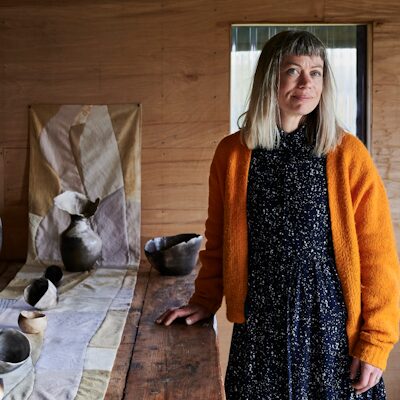Ceramicist and textile artisan.

Stark makes hand-built clay vessels that use the pinch and coil method, as well as textile wall hangings. Both strands of her work bring together organic shapes inspired by natural forms and the rhythms of the landscape. Nature is fundamental to her practice: in the smoke-firing technique that creates a brindled finish, and in the natural dyes she uses.
What’s your favourite clay to work with and why?
Ashraf Hanna. Clay of dreams for a hand builder. It’s very white, fires low and I rarely get a breakage when I smoke fire.
Do you have a favourite tool?
My gnarly hands.
You collect flora to fuel the firing. How do you choose what to pick up?
A structural seed head, or beautiful grasses swaying in the breeze. There must be a clump of them; I try to tread lightly on my surroundings so always leave some behind.
What do you enjoy about the smoke-firing process?
I love that you never know what you will get. I layer sawdust and wood shavings with my gathered materials on clay pots that I have carefully designed with surfaces I have chosen. I light a fire, let it catch and burn and put the lid on the container. But then, it’s up to the smoke to do its job and I can never be sure what magic will occur.
Describe your studio routine?
I do not have a routine of any description! Three teenagers, teaching and other artwork means I need to be flexible, and I have adapted my practice around that. If it means sewing into the night in front of the TV or dashing out to my studio to finesse a drying pot in between making tea for the children, then so be it.
What is something, non-art related, that is important to your practice?
I have an incredibly busy brain and have about one hundred things all going on up there, bashing into each other all the time. I used to think my art should enable me to escape from all of this. But what I’ve learnt is that my busy brain is my biggest tool, the source of my creative drive, and my secret weapon.
When did textiles become part of your practice?
I learnt how to make English patchwork at around the same time as I went to my first pottery class, aged ten or eleven. Patchwork was kept as a hobby. When I went back to West Dean College in my thirties it was pottery that led me, but soon afterwards the stitching came to join it. It couldn’t be kept in the background forever.
What are your favourite natural dyes?
I love rust. I have a rusty bucket full of old metal which I collect. I also really love playing around with hawthorn leaves or alder cones, which are easily collected, using soda ash and iron modifiers to shift the colours around.
Tell me about something that’s inspired you recently?
I went to see Drawing the Unspeakable at the Towner in January, and it was the most impactful exhibition I have seen for years and years.
What forms continue to inspire you?
Everything and nothing. Old churches, concrete brutalist architecture, the Sussex Weald landscape, grasses and prairie planting. But I studied archaeology at university so maybe, originally, a simple, hand-built prehistoric beaker.
Interview by Kate Reeve-Edwards
You can find Katharine on themakersdirectory.co.uk
